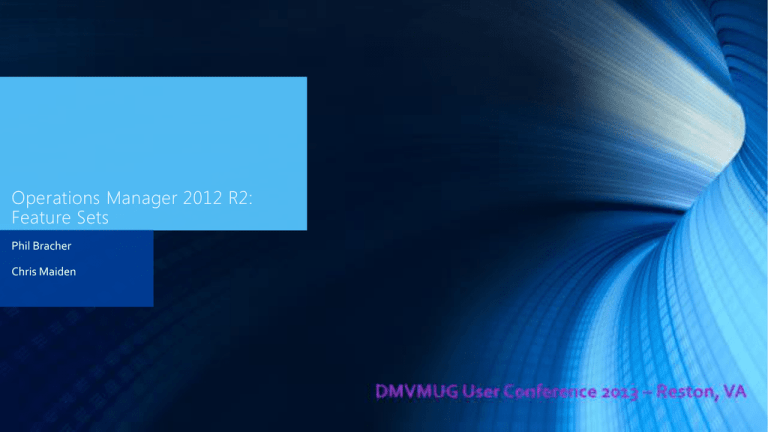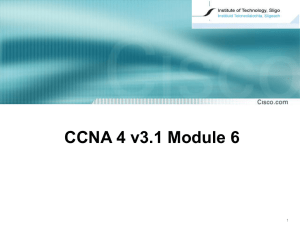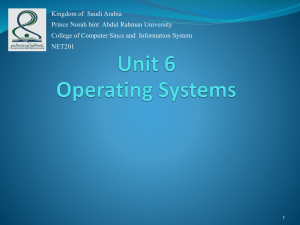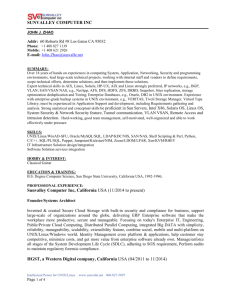OM2012-Feature-Set
advertisement

Operations Manager 2012 R2: Feature Sets Phil Bracher Chris Maiden Agenda Architectural change Operations Manager 2007 R2 Platform Parent child topology with the RMS as the parent and all other mgmt. servers as children. Operations Manager 2012, 2012 SP1 and R2 Platform Peer to Peer topology with all mgmt. servers acting as equals. Management server design What do you need to know about designing your management server? sizing helper tool Databases and reporting What database does it use and for what? Operational database: Data warehouse: How does report work and what needs to be considered? Architecture patterns Architecture example for infrastructure monitoring head with OpsMgr Management groups What is a management group? Basic unit of functionality: Why one should consider multiple management groups? Agents and watcher nodes Agents What does an agent do? Where can the agent be installed? What’s new in System Center 2012 R2 Operations Manager ? Hybrid monitoring Workload monitoring APM and infrastructure insight Predictable applications for your SLA’s Responding to application performance issues Alert is forwarded to Service Manager and incident is raised Expected user experience Developers Automated remediation Network Knowledge capture End user experience impact Infrastructure Resolve issue and close alert Java support Performance and Exception Events within SCOM Application Advisor • Method and Resource timing for Performance Events • Stack Traces for Exception Events • Java Specific counters for events (JVM Memory, Class Loader etc) • Subset of standard APM Reports Supported Ops Manager Level Alerting on Java Application Server counters • Requests / Second • Perf Events / Second • Exception Events / Second • Average Request Time Predictable application SLA: Global Service Monitor Web Test + Schedule Web Test Microsoft Visual Studio 2012 Operations Manager Workitem + Results On-premises ! Production Application Global Service Monitor Results Call Web App Results Global Service Monitor Global Service Monitor – What does it offer? • Availability • Provide the ability to understand the availability of your external facing services regardless of where they are hosted • SLA • Enable the ability to accurately measure and adhere to your SLA or the SLA provided by an external provider • Integration • Integrate seamlessly with your existing Operations Manager environment – part of 360 Application Monitoring • Efficiency • Managed by Microsoft • Extends your SCOM infrastructure to the cloud Availability SLA Integration Efficiency Developer – Operations “Communication” Open up the conversation! Key DevOps Scenarios Global Service Monitor using WebTests Allows sharing artifacts between Dev and Ops Easy configuration with Operations Manager Authoring Wizard Integrated with Team Foundation Server 2010 and Team Foundation Server 2012 Works together with any development process model in Team Foundation Server Provides two-way synchronization between Operations Manager and Team Foundation Server Application Performance Monitoring (APM) events can be open as IntelliTrace from Visual Studio 2012 Ultimate Deep-dive into problem root cause analysis with IntelliTrace Profiling Management Pack Extensibility thru System Center Orchestrator Get started quickly with application dashboards Create visibility into application performance Same information Same information Management server Web server OpsMgr DB OpsMgr DW 360o .NET application monitoring Displays information from • Global Service Monitor, • .NET Application Performance Monitoring • Web Application Availability Monitoring Summary of health and key metrics for 3-tier applications in a single view. Monitoring through Azure management pack Key capabilities • Enables customers to use OpsMgr to monitor availability and performance of Azure resources (Cloud Services, Virtual Machines, Storage) • Certificate expiration monitoring • Hybrid application monitoring • Use tasks to manually or automatically perform remediation • Topology dashboard to show how your services are connected • Simple setup and configuration Monitoring through Azure management pack Management pack template and distributed application template shows in a application perspective. Discovering stages ICMP Ping and/or SNMP Get • Uses SNMP v2c by default • ICMP Ping first Initial probing • SNMP Get next • Sends an initial ICMP and/or SNMP request to identify system • If no response: device is added to Pending • If SNMP v2c fails: SNMP v1 is tried Processing • Get components, IP addresses, VLAN memberships, resources, IP networks, netmasks and neighboring devices • Topology is created Post processing • Creates layer 2 and Layer 3 connectivity between the devices in the toplogy • Port stitching Discovery Events Event ID Description Event ID Description 12002 Full Discovery started for 1 request(s) 12007 PostProcessing completed 12121 Topology cleared successfully 12021 <IP Address> discovered successfully 12127 Proceeding to discover seed: <IP Address> 12014 No devices found in filtered list after discovery 12003 Probing <IP Address> 12008 Discovery completed 12004 Probing completed for <IP Address> 12023 Start processing connections to computers 12005 PostProcessing started 12024 Finished processing connections to computers Discovery methods • Customer knows the network devices • Manual process – add IP address or import list • Network topology unknown • Discovered based on a set of seed devices • Grabs ARP and IP tables and crawls network List of network devices with extended monitoring capability Monitoring the OS and workloads Support for the latest Windows platforms • Windows Server 2012, Windows Server 2012 R2 Updated support for Linux distributions • CentOS, Debian, Ubuntu • Red Hat Enterprise Linux • SUSE Linus Enterprise Server 45+ Management Packs (new or updated) released this year VEEAM Management Pack Amazon Web Services Management Pack Windows Server monitoring Agent auto detects Windows servers and by default monitors • Disk • Network • Windows itself Windows Server monitoring Each Windows server has its default health state defined by the Windows server development team • Availability—detects the roles, features, and services it is running and checks the health model • Configuration—detects activation status, service configuration setting, and results of best practice analyzer • Performance—checks available memory, memory pages per second, system page file, total CPU utilization and other performance counters • Security—monitors for security related setting Linux and UNIX monitoring Resource pool role in high availability scenarios Operations Manager Agent UNIX/Linux computers Supported operating systems: • • • • • • • • • CentOS 5 and 6 (x86/x64) Debian Linux 5 and 6 (x86/x64) HP-UX 11i v2 and v3 (PA-RISC and IA64) IBM AIX 5.3, AIX 6.1 (POWER), and AIX 7.1 (POWER) Novell SUSE Linux Enterprise Server 9 (x86), 10 SP1 (x86/x64), and 11 (x86/x64) Oracle Solaris 9 (SPARC), Solaris 10 (SPARC and x86), and Solaris 11 (SPARC and x86) Oracle Linux 5 and 6 (x86/x64) Red Hat Enterprise Linux 4, 5, and 6 (x86/x64) Ubuntu Linux Server 10.04 and 12.04 (x86/x64) Linux and UNIX Monitoring Each Linux and UNIX server has its default health state • Availability—detects the hardware availability including disk • Configuration—detects name resolution and WS-man health status for remote management • Performance—checks available memory, swap space, DPC time Linux Product UNIX Operations Manager Configuration Manager Endpoint Protection Virtual Machine Manager Future Hyper-V Future Future Future Azure IaaS Built-In monitoring Health and performance monitoring in Microsoft’s Linux/UNIX management packs CPU Memory Disk Network Processes Logfiles Custom monitoring What’s monitored Custom LogFile monitoring Service monitoring Command line rules and monitors • Monitor any logfile • Specify regular expression to match against • Target a single computer or group of computers • Monitor by name any service, daemon or process • Distinguish duplicate names with regex filter on process arguments • Specify minimum and maximum counts • Target a single computer or group of computers • Run any shell command line to determine health or performance • Target a single computer or group of computers New management packs SQL BI MP (Late Summer 2013) SQL 2012 MP update (July/August 2013) SQL 2014 MP (coincides with 2014 RTM date) SQL 2012 new monitors and rules • • • • • • • • • • • • • • • Collect DB Active Connections count Collect DB Active Requests count Collect DB Active Sessions count Collect DB Active Transactions count Collect DB Engine Thread count Thread Count monitor Transaction Log Free Space (%) monitor Transaction Log Free Space (%) collection Collect DB Engine CPU Utilization (%) CPU Utilization (%) monitor for DB engine Buffer Cache Hit Ratio monitor Collect DB Engine Page Life Expectancy (s) Page Life Expectancy monitor Collect DB Disk Read Latency (ms) Collect DB Disk Write Latency (ms) • • • • • • • • • • • Disk Read Latency monitor Disk Write Latency monitor Collect DB Transactions per second count Collect DB Engine Average Wait Time (ms) Average Wait Time monitor Collect DB Engine Stolen Server Memory (MB) Stolen Server Memory monitor Collect DB Allocated Free Space (MB) Collect DB Used Space (MB) Collect DB Disk Free Space (MB) SQL Re-Compilation monitor Performance monitors SPN monitor improved Support for special symbols in DB names Improved AlwaysOn seed discovery Run As configuration changes to support Low privilege for SQL Server 2012 Cluster Improved performance of AlwaysOn discovery Custom user policy discovery and monitoring performance optimization Hided AG health object from Diagram view Email: philbr@Microsoft.com christm@Microsoft.com Need more information on DMVMUG Visit www.dmvmug.com QUESTIONS?









